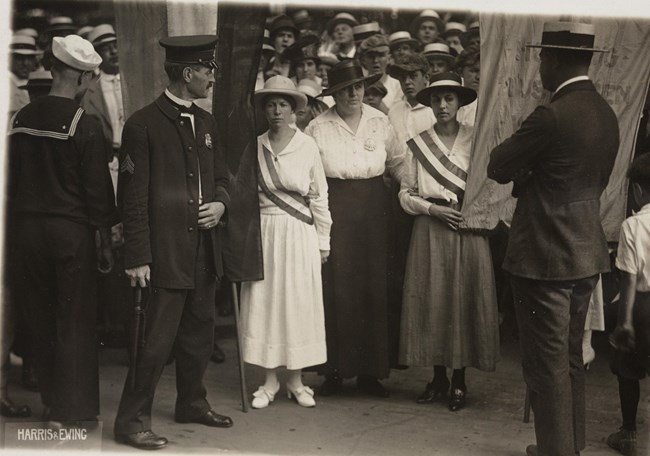Part of a series of articles titled Teaching Justice.
Article
Teaching Justice: Arrested

George Grantham Bain collection, Library of Congress
Grade Level
This activity is designed for students in fifth and sixth grades (ages 10-13).
Anti-Bias Objectives
Identity
Students will:
- recognize that people's multiple identities interact and create unique and complex individuals.
- recognize traits of the dominant culture, their home culture, and other cultures and understand how they negotiate their own identity in multiple spaces.
Justice
Students will:
- recognize unfairness on the individual level (e.g., biased speech) and injustice at the institutional or systemic level (e.g., discrimination.)
- identify figures, groups, events, and a variety of strategies and philosophies relevant to the history of social justice around the world.
Guiding Question
How does my identity affect how I interact with others?
The woman pictured above is not a police officer. She is posing for the photo in a proposed uniform for police women. Women working for social change in the early 20th century wanted more than just the right to vote. One of the things they demanded was equality in jobs and professions. The woman in this picture is a suffragist who is arguing that women should be hired as police officers.
In Washington, D.C., women began working for the police department in 1881. Three policewomen formed the Women's Bureau of the Metropolitan Police Department in 1918. During the early 1900s, women in the MPD were only allowed to handle police business involving women and children.
Activity
Examine the three photographs below which show moments when the suffragists interacted with the police in 1917 and 1918. Then answer the questions.

Photo #1
In this photograph, a woman police officer approaches a group of suffragists who are participating in a protest at the White House gates. On the left, Florence Youmans is holding on to a banner which the police officer is attempting to confiscate. To the right of the group of women, you can see other suffragists holding up banners. In the center, between Florence and the police officer, is Annie Arniel, who has also been protesting. Florence and Annie were arrested for refusing to surrender the banner.

Harris & Ewing, photographers. National Woman's Party collection, the Library of Congress
Photo #2
A female officer stands in between suffragists Catherine Flanagan and Madeline Watson, holding their arms. The women are wearing suffrage sashes and holding the banners that they have been using to protest at the White House. In January 1917, the National Woman's Party began picketing the White House to convince President Wilson to support women's right to vote. Crowds started attacking the women a few months later. People were angry at the suffragists for criticizing the president while the U.S. was fighting in World War I. The police told the National Woman's Party to stop picketing, but they refused. By the time this photograph was taken in August 1917, many women had already spent time in jail for picketing the White House.

Harris & Ewing, photographers. National Woman's Party collection, the Library of Congress
Photo #3
In this picture, taken in October 1918, the police officers arresting the suffragists are men. The officers are confronting a line of National Woman's Party protesters on Constitution Avenue. The suffragists wear sashes and carry suffrage banners. Women near the front of the line are being forcibly arrested, as police seize their banners, while two young men in foreground look on. When this picture was taken, it had been almost a year since the suffragists had picketed the White House. President Wilson began to support women's right to vote and had asked Congress to pass an amendment to the U.S. Constitution. These women are protesting at the Capitol, where Congress meets. Although a judge has ruled that the suffragists have a right to protest, these women are about to be arrested.
Vocabulary
confiscate: to take someone's property
picket: standing outside of a building or other location to protest or to try to persuade others to support a cause
suffrage: the right to vote
suffragist: someone who works for the right to vote, especially for women
Think About It
- Which woman is the police officer in Photo #1? How can you tell? Is it easier or harder to identify the police officers in Photo #3? Explain your answer.
- What differences do you see in the way the suffragists are arrested in the three pictures? Why do you think there are differences?
- Imagine that you are a police officer who has been given the job of arresting the suffragists. How do you feel about it?
Additional Resources
NPS Links
Women of the National Park Service Subject Site
Breeches and Blouses article about women's uniforms in the National Park Service
News Release: National Park Service Names Pamela A. Smith Chief of the U.S. Park Police
Other Links
Women in Law Enforcement: History, Accomplishments, and Demand Maryville University blog post
Women's Rights and the Civil Rights Act of 1964 at National Archives
Last updated: June 25, 2021
